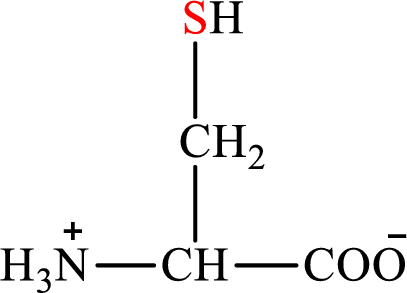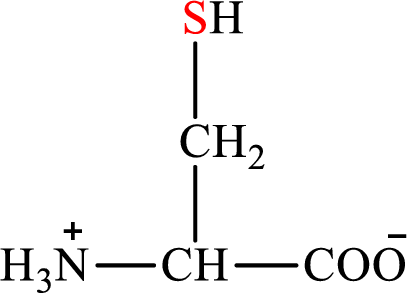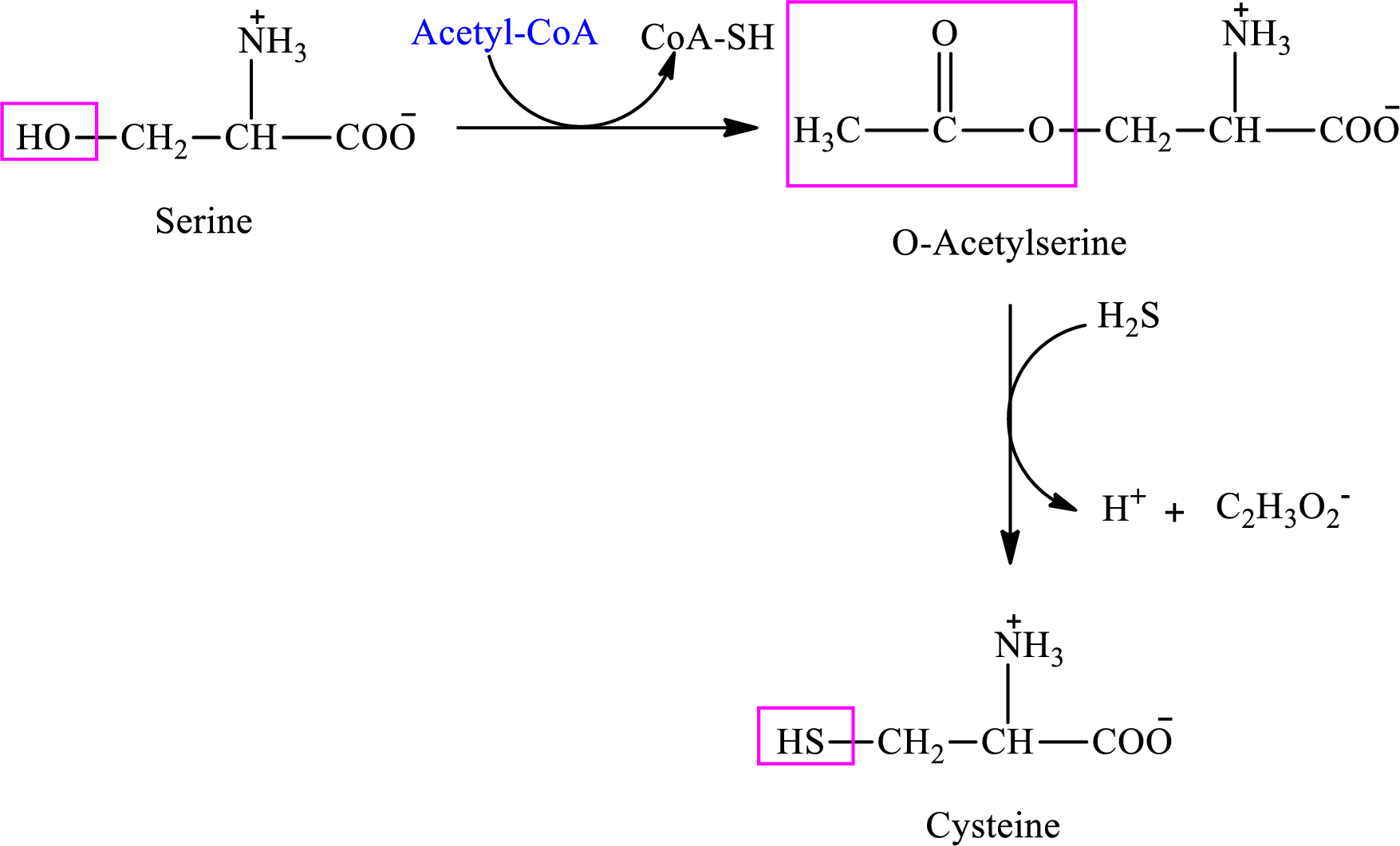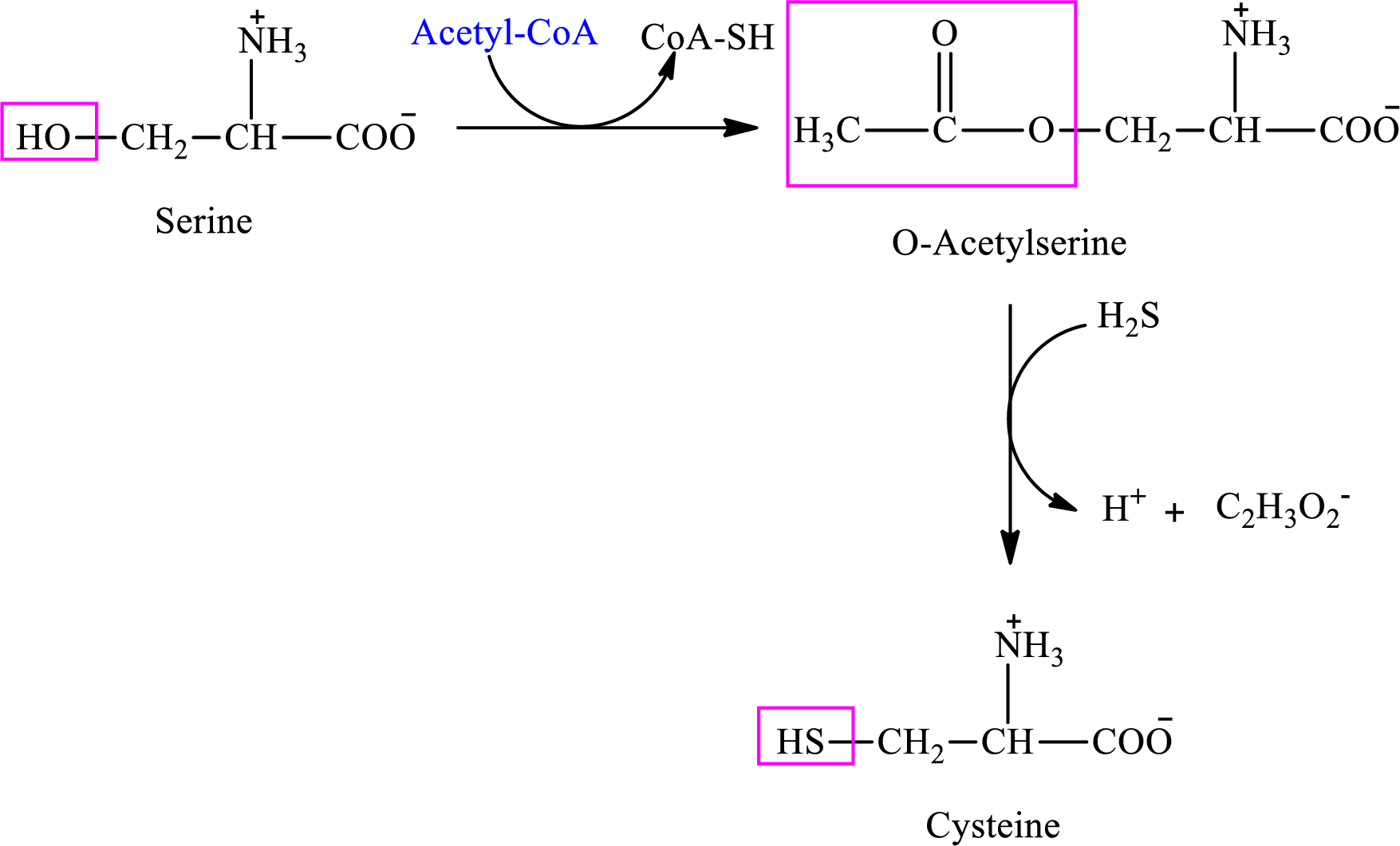
Concept explainers
(a)
Interpretation: To identify whether the statement “cysteine and serine are standard amino acids that contain the element sulfur” concerning sulfur-containing amino acids is true or false.
Concept introduction: Amino acids are the
There are 20 amino acids present in nature. These are arginine, histidine, isoleucine, leucine, lysine, methionine, phenylalanine, threonine, tryptophan, valine, alanine, asparagines, aspartic acid, cysteine, glutamic acid, glutamine, glycine, proline, serine, and tyrosine.
(b)
Interpretation: To identify whether the statement “the molecule
Concept introduction: There are 20 amino acids present in nature. These are arginine, histidine, isoleucine, leucine, lysine, methionine, phenylalanine, threonine, tryptophan, valine, alanine, asparagines, aspartic acid, cysteine, glutamic acid, glutamine, glycine, proline, serine, and tyrosine. Only two of the twenty amino acids have a sulfur atom in their structure. The two amino acids are cysteine and methionine. The structure of cysteine is:

Cysteine gives pyruvate as the degradation product. The degradation of cysteine is a two-step process.
(c)
Interpretation: To identify whether the statement “the first step in the synthesis of cysteine from serine is an activation step” concerning sulfur-containing amino acids is true or false.
Concept introduction: There are 20 amino acids present in nature. Only two of the twenty amino acids have a sulfur atom in their structure. The two amino acids are cysteine and methionine. The structure of cysteine is:

Cysteine is biosynthesized from serine that involves two steps.

(d)
Interpretation: To identify whether the statement “in the synthesis of cysteine from serine it is
Concept introduction: There are 20 amino acids present in nature. Only two of the twenty amino acids have a sulfur atom in their structure. The two amino acids are cysteine and methionine. The structure of cysteine is:

Cysteine is biosynthesized from serine that involves two steps.

Want to see the full answer?
Check out a sample textbook solution
Chapter 26 Solutions
EBK GENERAL, ORGANIC, AND BIOLOGICAL CH
- 3) Read the situations below and indicate which of the four methods of enzyme regulation is occurring for each. a) The energy-carrying molecule ATP is made by the enzyme ATP synthase. Muscle cells use a lot of energy and also have higher amounts of the ATP synthase enzyme than many other cell types. General mechanism of enzyme regulation: S b) Prostaglandins are messenger molecules involved in the inflammatory response, as well as the perception of pain. They are synthesized from polyunsaturated fatty acid substrates by an enzym called cyclo-oxygenase. "Ibuprofen" is the active ingredient in a variety of anti-inflammatory medications such as Motrin® and Advil®. It reduces pain and swelling by binding to a hydrophobic channel in the active site of cyclo-oxygenase, blocking the polyunsaturated fatty acids from binding to the enzyme, and therefore stopping production of prostaglandins. General mechanism of enzyme regulation:arrow_forwardWhich of the following statements about de novo purine synthesis is true? (A) Purine nucleotides are formed by separately synthesizing the phosphorylated ribose and the purine ring and then joining them together.(B) GMP is formed first and is used as a precursor to form AMP.(C) The synthesis of AMP from inosinate is driven forward by ATP hydrolysis. (D) GMP synthetase uses NADPH and glutamine to modify the inosinate ring to form GMP.(E) Replacement of the C-1 PPi on PRPP with an amine is required to construct the purine ring on the ribose sugar.arrow_forwardThe key regulatory enzyme in pyrimidine synthesis is: a. Aspartate transcarbamoylase. b. Glutamine phosphoribosyl amidotransferase. c. Uridine monophosphate synthetase. d. Orotidylate decarboxylasearrow_forward
- Answer A,B,Carrow_forwardRiboflavin (ry-boh-FLAY-vin), also called vitamin Riboflavin (ry-boh-FLAY-vin), also called vitamin B2, is required for synthesis of FAD. Predict the effects of a diet that is deficient in riboflavin., is required for synthesis of FAD. Predict the effects of a diet that is deficient in riboflavin?arrow_forwardWhich of the following is true about glycogen and amylopectin (starch)? a. Glycogen is abundant in the skeletal muscle, while amylopectin in the liver. b. Both are synthesized by most plants as their principle food reserve. c. Glycogen resembles amylopectin but is more extensively branched with α(1->6) linkages every 8 to 12 residues. d. Both are the storage polysaccharide of animals. e. Glycogen is a branched polymer, but amylopectin is a linear polymer.arrow_forward
- An animal cell is capable of converting alanine into serine. What is the shortest pathway using known enzymes by which this conversion could be accomplished? Show intermediates and cofactors; no enzyme names are required. (Hint: the first step is the removal of the nitrogen by transamination.)arrow_forwardThe effect of ATP on the allosteric enzyme PFK-1 is shown below. For a given concentration of fructose 6-phosphate, the PFK-1 activity increases with increasing concentrations of ATP, but a point is reached beyond which increasing the concentration of ATP inhibits the enzyme. (a) Explain how ATP can be both a substrate and an inhibitor of PFK-1. How is the enzyme regulated by ATP? (b) In what ways is glycolysis regulated by ATP levels? (c) The inhibition of PFK-1 by ATP is diminished when the ADP concentration is high, as shown in the illustration. How can this observation be explained? *A graph is included for this question*arrow_forwardA) Upon entering the body, CH3H9+ reacts with cysteine to form a molecule that is able to pass through the blood brain barrier (BBB). Draw the structure of this molecule and purpose why it is able to pass through the BBB (Hint: think about another amino acid). B) The adduct formed in part A is very labile. On encountering selenocysteine, it can permanently inhibit it. Propose how the adduct from Part A inhibits selenocysteine and explain your answer.arrow_forward
- If you fed a mouse a diet made up of exclusively Leucine, the mouse would eventually: A、Undergo extensive gluconeogenesis B、Enter ketosis C、Have a buildup of α-Ketoglutarate D、gain weight E、have a buildup of succinyl-CoAarrow_forwardAMP- PNP is a non-hydrolyzable ATP analog that cannot be metabolized by cells. Taurocholate is a bile acid that helps emulsify fats. When taurocholate is added to hepatocyte cell culture, it accumulates in those cells. The graph below shows the rate of cellular accumulation of the drug taurocholate in the presence of either ATP, ATP, or AMP-PNP. Based on this date, describe the mechanism by which taurocholate enters the cell. Justify the answer.arrow_forwarda.) in human, under what condition will pyruvate be converted to lactate? what type of reaction occurs when pyruvate is converted to lactate? b.) in human, what happens to pyruvate when there is sufficient oxygen supply? which enzyme is involved in this chemical reaction?arrow_forward
 Human Anatomy & Physiology (11th Edition)BiologyISBN:9780134580999Author:Elaine N. Marieb, Katja N. HoehnPublisher:PEARSON
Human Anatomy & Physiology (11th Edition)BiologyISBN:9780134580999Author:Elaine N. Marieb, Katja N. HoehnPublisher:PEARSON Biology 2eBiologyISBN:9781947172517Author:Matthew Douglas, Jung Choi, Mary Ann ClarkPublisher:OpenStax
Biology 2eBiologyISBN:9781947172517Author:Matthew Douglas, Jung Choi, Mary Ann ClarkPublisher:OpenStax Anatomy & PhysiologyBiologyISBN:9781259398629Author:McKinley, Michael P., O'loughlin, Valerie Dean, Bidle, Theresa StouterPublisher:Mcgraw Hill Education,
Anatomy & PhysiologyBiologyISBN:9781259398629Author:McKinley, Michael P., O'loughlin, Valerie Dean, Bidle, Theresa StouterPublisher:Mcgraw Hill Education, Molecular Biology of the Cell (Sixth Edition)BiologyISBN:9780815344322Author:Bruce Alberts, Alexander D. Johnson, Julian Lewis, David Morgan, Martin Raff, Keith Roberts, Peter WalterPublisher:W. W. Norton & Company
Molecular Biology of the Cell (Sixth Edition)BiologyISBN:9780815344322Author:Bruce Alberts, Alexander D. Johnson, Julian Lewis, David Morgan, Martin Raff, Keith Roberts, Peter WalterPublisher:W. W. Norton & Company Laboratory Manual For Human Anatomy & PhysiologyBiologyISBN:9781260159363Author:Martin, Terry R., Prentice-craver, CynthiaPublisher:McGraw-Hill Publishing Co.
Laboratory Manual For Human Anatomy & PhysiologyBiologyISBN:9781260159363Author:Martin, Terry R., Prentice-craver, CynthiaPublisher:McGraw-Hill Publishing Co. Inquiry Into Life (16th Edition)BiologyISBN:9781260231700Author:Sylvia S. Mader, Michael WindelspechtPublisher:McGraw Hill Education
Inquiry Into Life (16th Edition)BiologyISBN:9781260231700Author:Sylvia S. Mader, Michael WindelspechtPublisher:McGraw Hill Education





